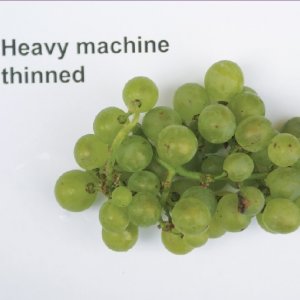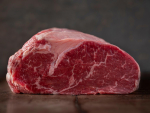There have also been some revelations in terms of what impact the regime has on fruit development, soluble solids and the ensuing wines.
In the Marlborough trials, fruit was considered from four different scenarios. An un-thinned control, a lightly machine thinned, a heavily machine thinned and a hand thinned, where fruit bunches were removed from the top cordon.
Dr Mike Trought from Marlborough Plant and Food Research, says during last year’s
trials on Sauvignon Blanc, it was obvious
that a few weeks after the vines had been thinned, the berries were generally smaller when compared with the non-thinned control block.
“This occurred within the first two weeks, (after thinning) and that reduction in berry size carried on through to harvest. By then the machine thinned berries were significantly smaller than the non-machined. Was this because we had taken the big berries off, or was something else going on?”
Close inspection of the fruit taken off, showed that it wasn’t larger berries being removed. So more monitoring was undertaken this year, which showed the vines appeared to be showing some signs of stress immediately after the thinning machines had gone through.
“We noticed that the shoots, particularly on the Pinot Noir, had curled over,” Trought says. “It looked as though the vines were being slightly water stressed. The following day though, they had recovered.”
After measuring the berries on the machine thinned and comparing them with the berries on the control, it became apparent that there was a significant reduction in berry growth rate on the vines thinned.
“So what we are hypothesising is apparent water stress has stalled berry growth. If you were looking at Merlot or Pinot Noir, then maybe smaller berries could be an advantage.”
In terms of fruit yields – there was a significant difference between the treatments.
The control vine had 16 kg of fruit (these were bigger than average vines on the Wairau Plains.)
The light machine thinned had 12.5 kg of fruit.
The heavily thinned vines had 9.5 kg.
Hand thinning had 12kg of fruit.
What was interesting was bunch numbers for each block weren’t significantly different. The weight difference was due to smaller bunches caused by the smaller berries and the removal of some berries and parts of bunches during thinning.
While the machine thinned blocks were initially later to begin ripening, they caught up by harvest, and reached required brix levels much earlier than the control, un-thinned block.
Trought says wines were then made, to determine if there were any significant differences between the fruit composition of machine thinned, hand thinned and non-thinned. All fruit was picked at 21 brix, with the hand thinned block being the first to reach that level. The machine thinned reached 21 brix four days later, and then the control block 11 days after that.
Acidity wise, it was the hand thinned fruit that had the highest levels. The phenolics of the machine thinned were virtually the same as the control and just slightly higher than the hand thinned.
“Interesting though,” Trought says, “was the effect the thinning had on thiol concentrations – those passion fruit concentrations that come through in the wine. The control wine had significantly higher thiols than in any of the thinning treatments. We don’t know why, but there are two possibilities. We know that thiols tend to increase with time and we have data that shows the thiol concentrations in the wines that are harvested late, tend to be higher than the ones harvested early, even at the same soluble solids.
“We also know thiol concentrations are influenced by the level of disease, particularly botrytis.”
The finished wines were then exposed to a group of experienced winemakers and viticulturists. They were all asked to rate each wine over a range of parameters such as stone fruit, tropical, green capsicum, astringency to acid.
“One of the significant results was that hand thinning resulted in significantly higher green capsicum and acidity characteristics when compared particularly to heavily machine thinned.”
The acidity of the wines show statistically very little difference in the machine thinned when compared with the control and generally were lower than the un-thinned control. In terms of astringency, it was highest in the hand thinned, lower in the machine thinned and lower still in the control.
“So reducing the crop load on your vines increases the acidity and methoxypyrazine concentrations of that fruit, at the same soluble solids. The idea that you will reduce acidity by taking fruit off, is a mistake. The reason for this is the thinning treatments you are imposing are having a greater effect on the sugar accumulation than you are having on the rate of acid degradation . You are getting to the target soluble solids earlier before the acidity or the methoxypyrazines have had a chance to degrade away.”
Perhaps one of the most important aspects of the panel undertaking the tasting, was their ability to define whether or not the wines were “typical” examples of Marlborough Sauvignon Blanc. Trought says while typicity is always a subjective issue, trends can become apparent when asking a group of 20.
The outcome? Well the mechanically thinned wines showed no significant levels of difference in complexity or typicity when compared with the control wines.
Future research, funded by New Zealand Winegrowers and Sustainable Farming Fund, will once again see wines made from the trial and control blocks this year. However for the first time those trials will also include Merlot, Pinot Gris and Pinot Noir. ν










